Which type of bone is scapula? Where is it located?
Scapula is a flat bone. the body of scapula is thin , flat and triangular with two surfaces- ventral and dorsal. Scapula lies on the posterolateral aspect of the thorax extending from 2nd to 7th rib.
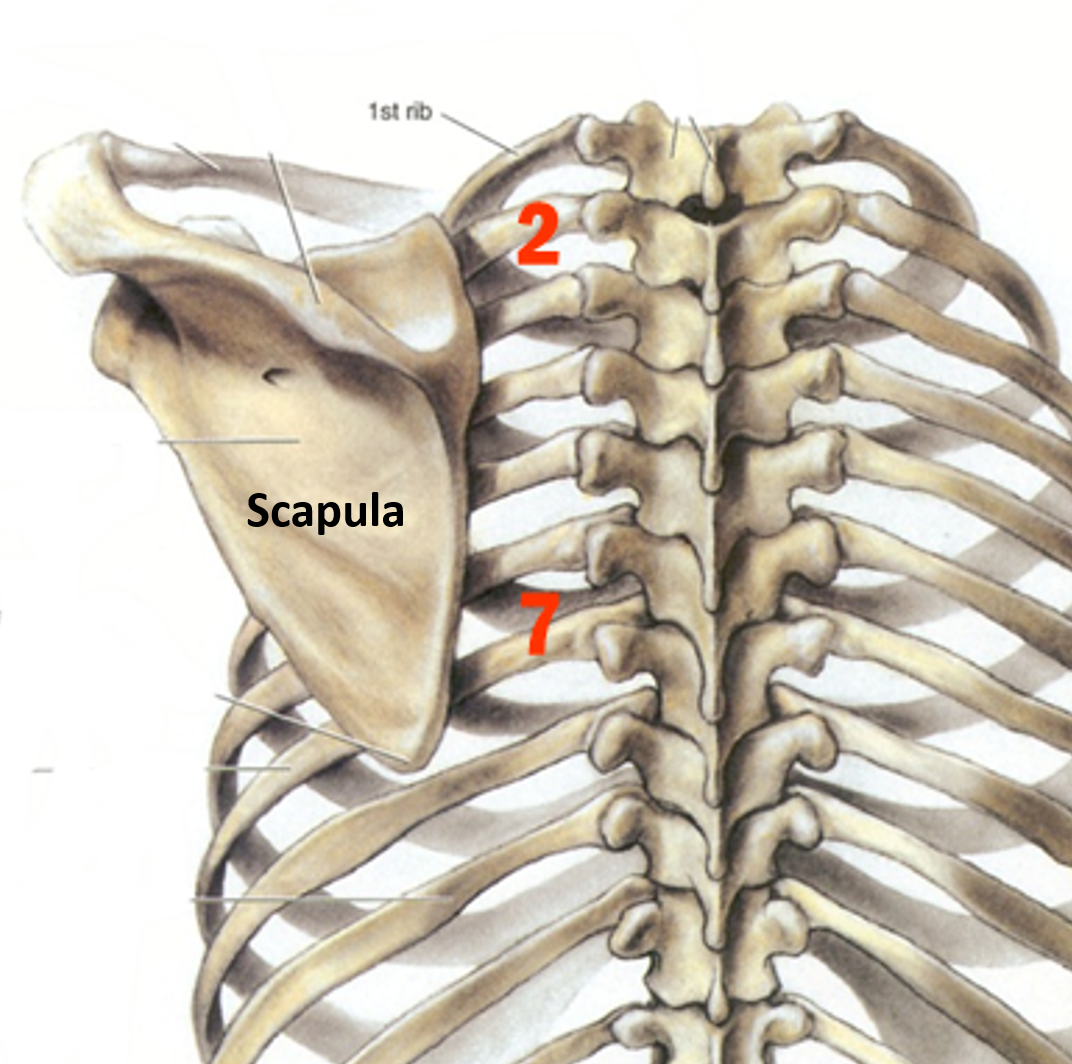
What are the different parts of scapula?
Scapula has
A body which is triangular in shape. It has
- three angles( superior, inferior and lateral). At the lateral angle there is a shallow pear shaped fossa called glenoid cavity.
- three borders ( superior, medial and lateral).
- Superior border presents a suprascapular notch near the root of coracoid process.
- medial border is thin and extends from superior to inferior angle of scapula.
- Lateral border is thick and extends from glenoid cavity to inferior angle.
- two surfaces (costal (ventral) and dorsal).
- ventral surface is concave and is called subscapular fossa.
- Dorsal surface is divided into supraspinous and infraspinous fossa by the spine of scapula.
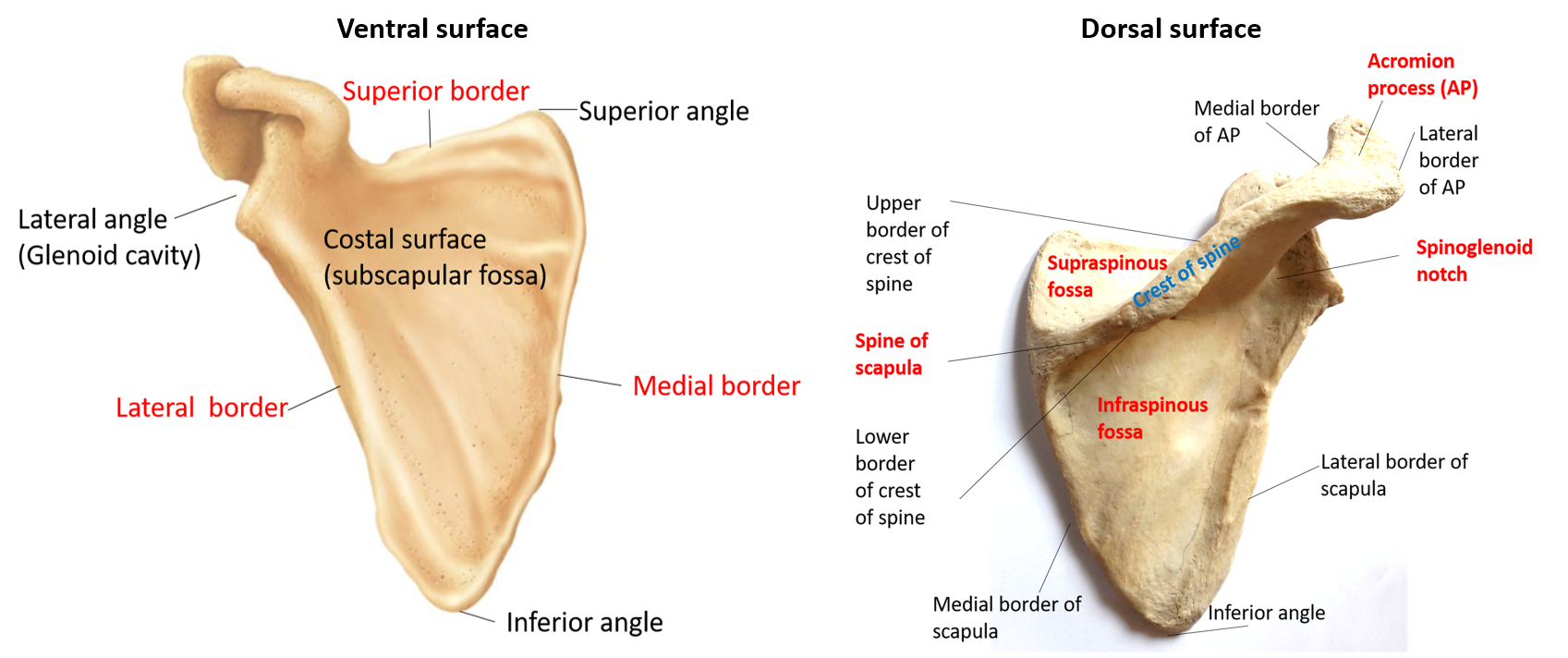
Three processes ( Spine,acromion and coracoid)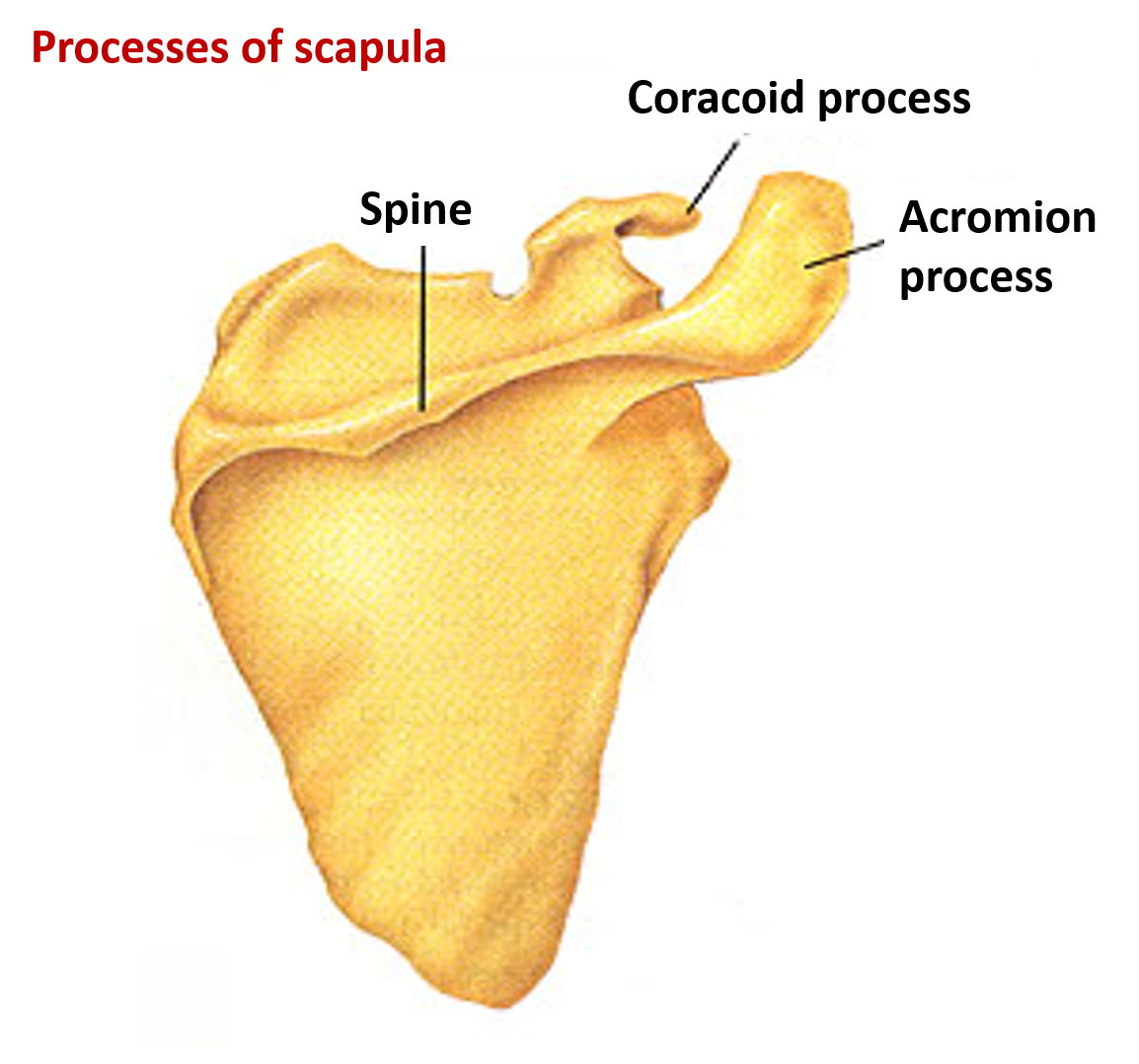
- Spine of scapula is present on the dorsal aspect of the body of scapula and is triangular in shape. Its anterior border is attached to the body of scapula and the posterior border known as ‘çrest of spine’ is free. The crest of spine of scapula has two border (lips) upper and lower . The lateral border of spine forms the boundary of spinoglenoid notch.
- Acromion process is a forward projection from the lateral end of spine. It has medial and lateral borders and superior and inferior surfaces. It has an articular facet near the tip which articulates with lateral end of clavicle.
- Coracoid process: is present above the glenoid cavity and is shaped like a bent finger. it provides attachment to 3 muscles and 3 ligaments.
How can you determine the side of the bone?
In order to determine the side one must known that
- Inferior angle is directed inferiorly.
- Dorsal surface bearing spinous process is directed posterioly.
- Glenoid cavity faces laterally.
How to hold scapula in anatomical position?
A. Hold the bone in such a way that costal surface faces anteromedially and glenoid cavity faces anterolaterally and a little upwards.
Name the muscles attached to the scapula.
The following muscle are attached to different parts of scapula.
Muscles attached to the three foassae of scapula
- Costal surface ( subscpular fossa) : it’s medial two third provides origin to subscpularis muscle.
- Dorsal surface: Suprispinous fossa and upper surface of spine of scapula gives origin to supraspinatus muscle .
- Infraspinous fossa and inferior surface of spine of scapula gives origin to infraspinatus muscle.
Muscles attached to the three borders of scapula
- Medial border – Costal surface (including that of inferior angle) provides attachment( insertion) to serratus anterior.
- Medial border – Dorsal surface form above downwards provide attachment to three muscles i.e. levator scapulae, rhomboideus minor and romboideus major.
- Lateral border : Its dorsal surface gives attachment to teres minor ( upper 2/3rd) and teres major (lower 1/3rd).
- Superior border: Inferior belly of omohyoid is attached on the superior border near the suprascapular notch.
Muscles attached to the Three processes of scapula
- Crest of spine of scapula and borders of acrominon process:
- Deltoid muscle takes origin from the inferior lip(border) of crest of spine of scapula and lateral border of acromion process.
- Trapezius is inserted on the upper lip ( border) of the crest of spine and the medial border of acromion process.
- Coracoid process: Coracobracialis and short head of biceps brachii arises from the tip of coracoid process. pectoralis minor is inserted on the superior surface of coracoid process.
Muscles attached to the inferior angle, supragenoid tubercle and infraglenoid tubercle.
- Supraglenoid tubercle: provides origin to long head of biceps brachii.
- Infraglenoid tubercle: provides origin to long head of triceps.
- Inferior angle: its dorsal surface provides attachment to latissimus dorsi.
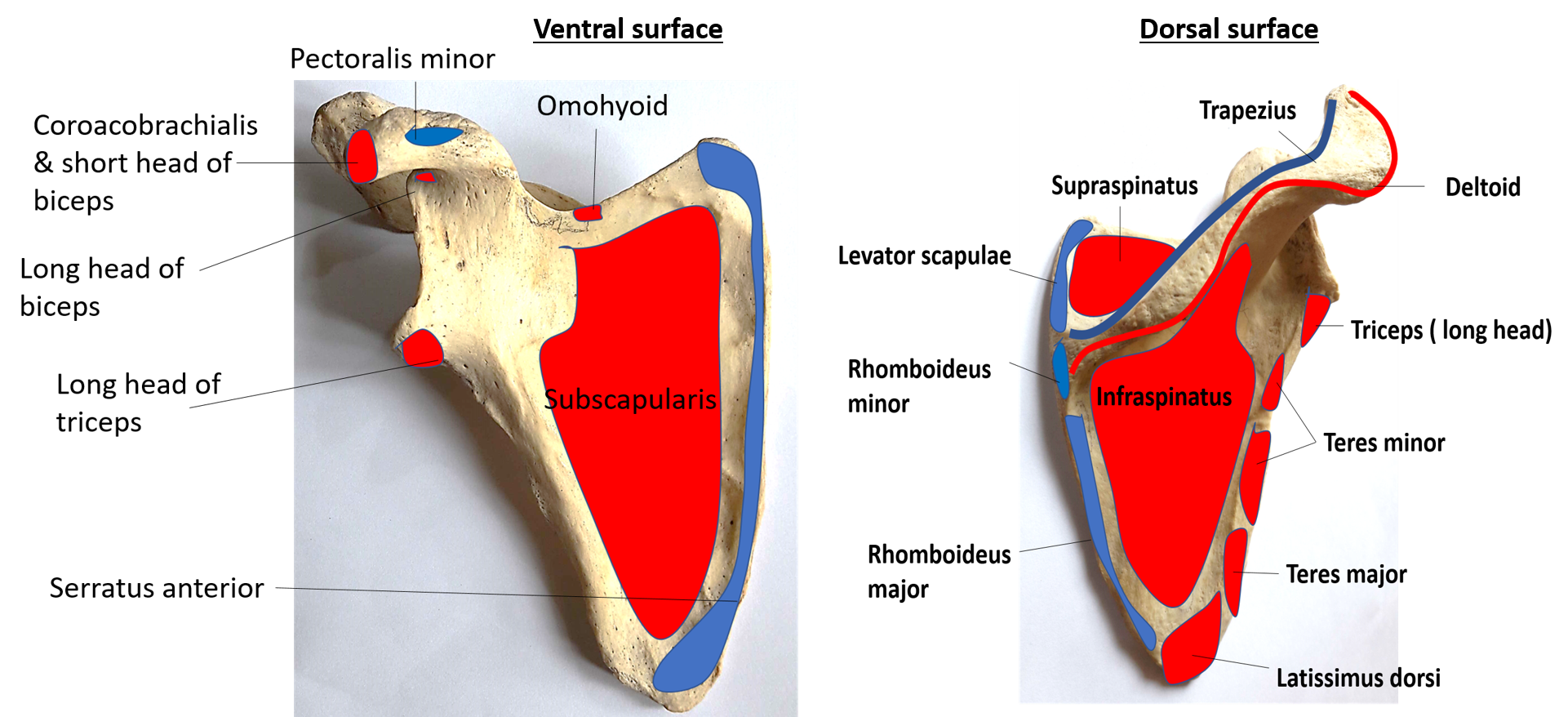
Name the ligament attached to the scapula.
The following ligaments are attached:
- Suprascapular ligament is attached on either end of the suprascapular notch. Suprascapular vessls pass above the ligament and suprascapular nerve below the ligament. The vessels and nerve then run along spinoglenoid notch to reach infraspinous fossa.
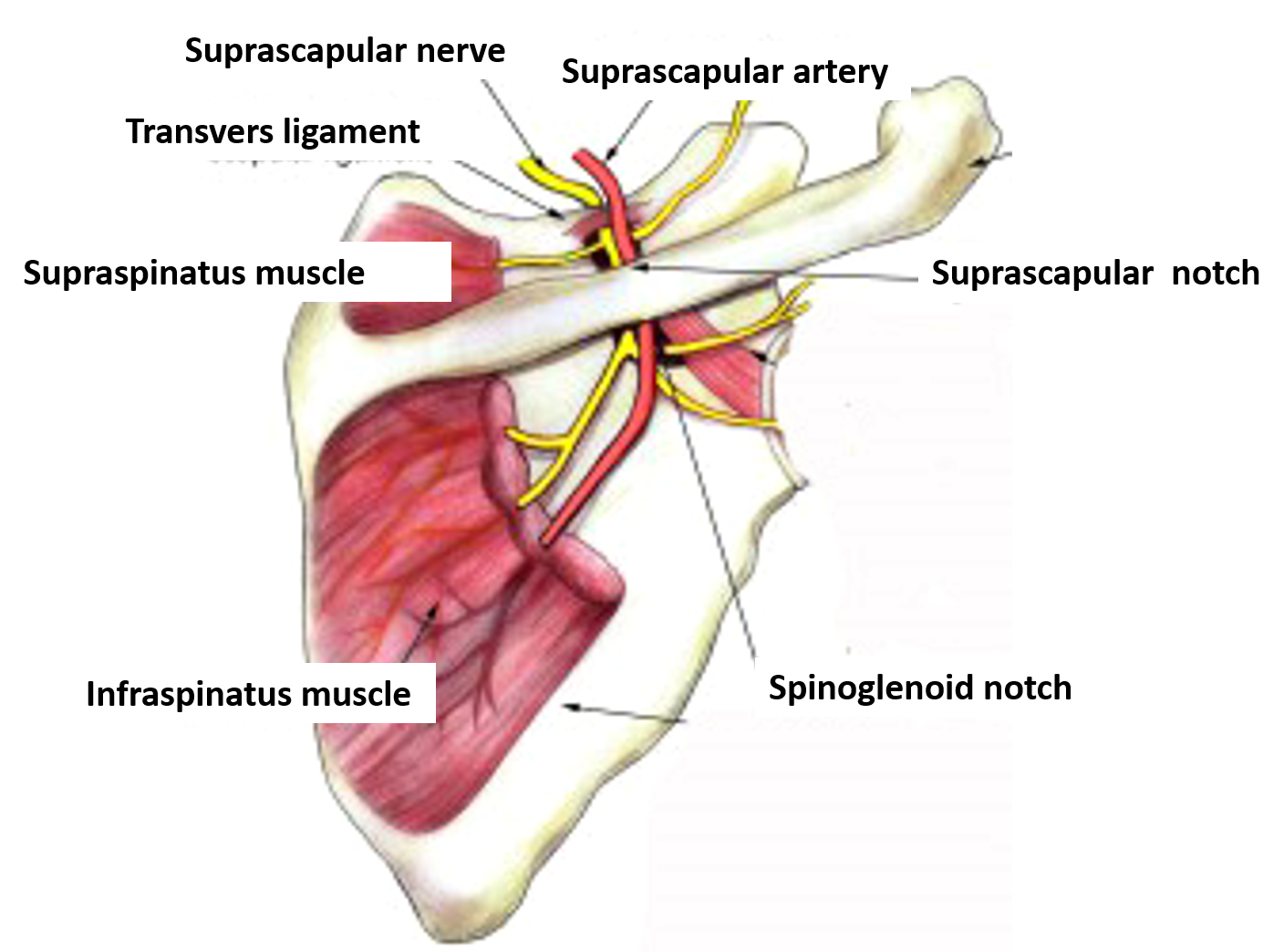
- Three ligaments are attached to coracoid process: coracohumeral ( to the root) , coraoacromial ( to the lateral border). and coracoclavicular ( conoid part near the root and trapezoid part on the superior aspect).
Name the structures attached to coracoid process.
Structures attached to coracoid process are:
- 3 Muscles: corachobrachialis, short head of biceps brachii, pectoralis minor.
- 3 Ligaments: coracohumeral, coraoacromial and coracoclavicula.
How does scapula ossify?
Scapula ossifies from 1 primary centre and 7 secondary centres of ossification ( 2 for coracoid process, 2 for acromion,1 each for glenoid cavity, inferior angle and medial border). Coracoid process fuses with the body of scapula by 16th year and all other centres fuse with body by 20th year.


Thank you I’m finding this stuff really helpful I’ve just stopped ready from text books after finding this
Hi, I want to use images of muscle attachment of scapula for my article on scapula surgery and anesthesia..Kindly let me know if i can use it with reference of ur website….
Absolutely well
I’m happy that I found this site. It has made reading interesting and encouraging. Before now reading my Anatomy textbook was a hideous task that needed to be done but now I enjoy Anatomy and won’t hesitate to recommend this site. I wish there was such a site for physiology.
Thanks and God bless you.
IT VERY GOOD FOR BEGINNERS LIKE MYSELF
Thank you so much, It’s very usful for me to learn, to study and to teach the students.